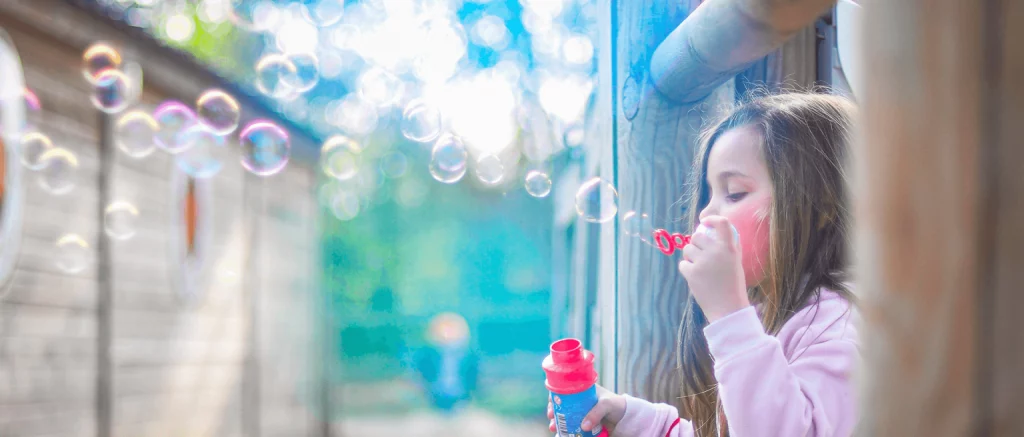13 Mindfulness Activities For Kids that Are Both Fun and Teach Mindfulness
1. Blower some bubbles
Kids love bubbles! Your children should take a slow inhale and relax while they exhale. Ask them to imagine their worries inside the bubble. The bubble will then float away into the air and pop. The bubble will disappear, and so will the worries of the children. This is a great way to teach children mindful breathing. It can help them quickly calm down in stressful situations.
It is also a mindful activity to blow bubbles. This gets kids out of their heads so they can focus on blowing bubbles. You want to push them and make them more focused? You can challenge them to blow the largest bubble possible! As they attempt after attempt, watch as their eyes light up.
2. Concentrate on the five senses
Your children can learn to be present and aware of the present moment by using their senses. This mindfulness exercise helps them forget their worries and allows them to be present in the moment. Focusing on each sense for a few minutes can help calm anxious thoughts.
The 5 senses exercise requires children to look around and ask the following questions:
- What can I see?
- What can I listen to?
- What scents can I detect?
- What can I do?
- What can I eat?
Use props, even items they haven’t seen or smelled before. Ask them to describe the object using their senses. Is it rough or soft? Is it heavy? Is it strong or weak?
3. It is possible to draw it out
Drawing is a great way to bring mindfulness to your kids. Ask your children to shut their eyes and find something that makes them smile. After they have chosen something, you can give them a notebook with crayons and ask them for help drawing it.
Ask them to imagine how the crayon feels when they’re drawing. Next, ask them to pay attention to the texture of their paper. Ask them to describe the colors used in the image. By directing their attention to drawing, this will calm any anxious thoughts.
Encourage your child’s ability to talk out loud about what they are drawing. It’s possible for them to become distracted while drawing and start talking about other things. Ask them gently to describe what they are doing when this happens. “What are your current activities?” “Which section are you currently drawing?”
4. Take a mindful snack
You can teach your children the art of mindful eating by offering them healthy snacks such as an apple and granola bars. Ask them to carefully examine the snack before they bite into it. Ask them to describe the texture of the snack in their hands. Tell them to take a bite and then think about the texture and flavor of the snack.
Mindful eating offers many benefits. Mindful eating can calm anxiety and prevent bad eating habits like binging. Studies also show that it helps the body recognize fullness more easily. A snack can be made more enjoyable by focusing on the experience.
5. Take a walk
You can reduce stress levels by engaging in physical activity. Take your children for a stroll around the neighborhood. It doesn’t matter if your kids know that it’s a walking meditation. However, it can be a very mindful experience. This is a great way to teach children mindfulness and to help them appreciate the beauty of their surroundings. It can be difficult to keep kids still for more than a few seconds while you do mindfulness exercises together.
Ask them to describe what they see while you’re out. Ask them to point out and notice any sounds or noises. Ask them to identify any smells. Ask them to name the colors they see. You can make it more of a game, and also incorporate mindfulness training. Have them call out the colors and ask them to identify or point out objects that match the color. Red, orange, yellow, green, blue, purple.
6. Do some buddy breathing
Young children might struggle to understand the concept of mindful breathing exercises. You can ask a friend bear for help. Lay your children on their backs. Ask your children to place a stuffed animal on their stomachs and gently ask them to put their hands over the animal. Tell them to count to three and to inhale through their noses. Encourage them to inhale and focus on the sensation of the air expanding their stomachs. Let them count to four and then have them inhale through their mouths. As they inhale, the stuffed animals will rise and fall. This provides a visual representation of their internal workings.
Deep breathing is an excellent mindfulness exercise. According to a University of Waterloo study, mindful breathing can improve brain function and energy levels. This exercise can also help calm anxious children.
7. Create your stress balls
This craft is great for kids and can be used as a mindfulness tool. Use colorful balloons to make a funnel and place it in your neck. Your children will help you carefully pour the filling. For squishy stress balls, you can use cornstarch, flour, or sand. Dry rice or birdseed can be used for a firmer texture, and less mess.
After the balloons have been filled, tie them and allow the children to decorate the outside of the balloons with paint or stickers. With just one squeeze, stress balls can be used to help kids relieve negative emotions. These balls are great for meditation and as a focus point.
8. Feel the beat
Jump jacks and running in place for 30 seconds are great ways to get your children moving. When they’re done, ask them to sit down and place one hand on their hearts. Ask them to pay attention to how their heartbeats are feeling. Ask them to feel if their heartbeats slow down when they are resting. Next, ask them to pay attention to their breathing. Next, ask them to focus on their breathing. Encourage them to share other sensations that they feel during the exercise. This exercise is great for teaching mindfulness to elementary students, as it combines physical activity with mindful awareness.
9. Use prompts to journal
A simple writing activity can help children learn mindfulness. Give your child a piece of crayon or construction paper in their favorite color and ask them to draw and write from the prompt: “Today, I feel …”.” Make sure you tell them that there is no right or wrong answer. A child can express their feelings by drawing a sun.
You can give them different colors of paper for each day of the week. The prompt is already written for them. This can be done in the morning or after school. This activity can be done privately or for fun once it becomes a regular routine. Instead of merely perceiving or sensing these feelings, they begin to put them on paper and give them a name. This will help children to be more aware of the different feelings they experience throughout the day and practice mindfulness.
10. A simple and enjoyable body scan
A formal meditation practice can be difficult for children, but a simple body scan you can guide your child through can be one fun mindfulness activity you can teach them. Start the “body scan” game by having your child lie down and closing their eyes. Next, ask your child to use their hand to contact different parts of the body. This is probably easier if they are doing it with their eyes closed and watching you.
“Hand to the top of your head. How does the top feel? Is it hot? Is it hairy? Is it soft? Is it round?
“Hand to your belly. How does your belly feel? Do the clothes feel soft? Is the stomach itchy?
Continue to guide them with fun prompts, silly names, and descriptions of body parts. Ask them to describe the part in their current moment.
11. Mindful listening
Although it takes some preparation, this mindfulness practice for children is one of the most similar to formal meditation and mindfulness that any child can do. This can be used to teach mindfulness to students younger than 12.
You can set up a mindful listening activity in two ways. First, have your children open their eyes or close them and listen to common animal sounds. Then have them write or speak the names of the animals. Mindfulness is something students can learn by paying attention to just one sense.
Another mindful listening activity you could try is more complicated but still makes this a fun and enjoyable game. Play two identical sound clips and have the children add a subtle sound effect. Then ask them to identify the difference between the clips. You could, for example, play a 10-second audio clip that shows people playing basketball. The second time you play it you add a windchime sound effect. You can also use games to teach mindfulness to kids. You can introduce games to mindfulness activities for kids if you find that some age groups aren’t as interested in it as others.
12. Gratitude exercise
Mindfulness is more than focusing on the present moment and your senses. You can also do mindfulness activities for children. It’s a great way to teach mindfulness and instill positive emotions by reminding your children to be grateful. It might surprise adults to see the results! It’s amazing how creative and bright some of the answers can be. You may find new perspectives and things to be grateful for as an adult.
It should be a regular part of your day with them. You can do it while you have breakfast, pick them up from school, and/or when they go to bed. Ask them to tell you what they are thankful for today. If they give the same answer repeatedly, you can ask them to repeat it. If your child struggles to find an answer, you can share what or who you are thankful for with them.
13. Mindfulness meditation for children
There are also formal meditation practices that can be used to help kids learn mindfulness. Before you start thinking about teaching meditation to children, I recommend that you first explore the activities for kids mentioned earlier. When the child has already practiced mindfulness and being present through the activities mentioned, meditation is possible. You have many resources and tools to assist you in this endeavor.












